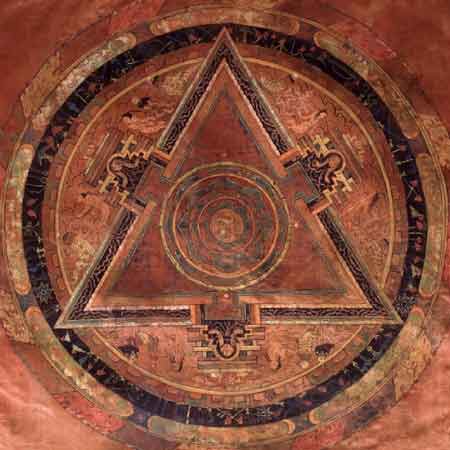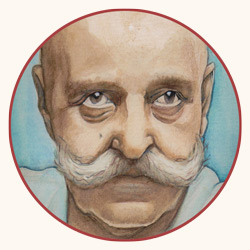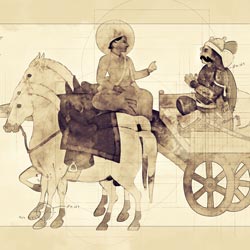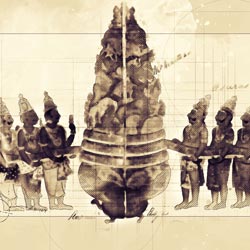
Approaching the Law of Three
In their first meeting in the spring of 1915, Ouspensky was struck by Gurdjieff’s knowledge, knowledge he had himself sought in the east without success. Gurdjieff could explain the most mysterious phenomena and reconcile seeming contradictions between different teachings. “But all the same,” said Ouspensky after one of their early discussions, “the most important thing is facts. If I could see genuine and real facts of a new and unknown character, only they would finally convince me that I am on the right way.”i
A year and a half later, in the summer of 1916, the facts arrived. Gurdjieff gathered his students in Finland for more concentrated work. Ouspensky had prepared for this gathering by carrying out various breathing, fasting, and mental exercises that had brought him to a state of unusual tension and laid the ground for the extraordinary experiences he would undergo. Throughout the Finland gathering, Ouspensky went in and out of remarkably higher emotional states, states that brought with them new perceptions and realizations. These states—described in his book In Search of the Miraculous—were so unlike anything he had ever experienced before, that they would affect permanent changes in his relation to himself and those around him. He recognized that these were the facts Gurdjieff had promised him earlier. What had been missing then, that was present now, was emotional preparation. “This state,” Ouspensky concluded, “which is emotional, is exactly what we do not understand, that is, we do not understand that it is indispensable and that facts are not possible without it.”i
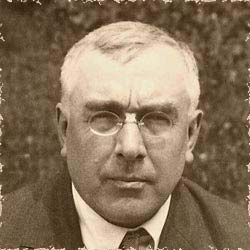
Peter Ouspensky
Intellectual and Emotional Approach to the Law of Three
By the same token, we must aim to establish an emotional relation to all the ideas of this teaching, including the law of three. Intellectually, we study the need of three forces. We study the invisibility and elusiveness of the third force. And we study how different variations of three forces create different triads. Ultimately, though, it is our emotional center that learns the flavor of ascending and descending octaves. It comes to recognize the different character of form, matter, and life. Only then does the law of three become an integral part of ourselves so as to influence our actions.
When the Finland gathering concluded, Ouspensky’s higher states subsided, though not without leaving an important trace. “Certain very definite changes began in my views on myself, on those around me, and particularly on ‘methods of action,'” reported Ouspensky after the event. “They were not in any way connected with what was said in Finland but they had come as a result of the emotions which I had experienced there…” “Somewhere very deep down inside me I understood the esoteric principle of the impossibility of violence, that is, the uselessness of violent means to attain no matter what.” i
The law of three dictates that any result can only be attained through the marriage of three forces. The relation of these forces to each other determines the nature of the triad. If I want to recruit your help, I can force you to help me, beg you to help me, or inspire you to help me. Each represents a different triad for for achieving the same aim, and, needless to say, each will yield a different result. This was Ouspensky’s takeaway from the Finland gathering. It would lead him to reevaluate his relations to others, including his own teacher, George Gurdjieff.
In surveying the law of three, we should likewise adopt both an intellectual and an emotional approach.

Peter Ouspensky
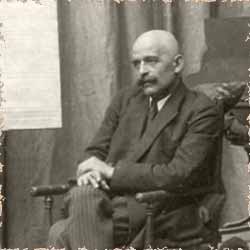
George Gurdjieff

George Gurdjieff



The Function of Laws
[GURDJIEFF] “Man is an image of the world. He was created by the same laws which created the whole of the world. By knowing and understanding himself he will know and understand the whole world, all the laws that create and govern the world.” i
To understand the Law of Three, we must understand how laws function in general.
In a village of ten families few laws are necessary. The mayor can maintain order in person. He can ask the bar owner to close by ten so as not to disturb the neighbors. He can ask the florist to keep her dog on a leash so as not to scare the children. And he can ask the farmer to keep his donkey away from the main square so that it not eat the gardenscape. In a village of a hundred families, such personal government becomes more difficult, and in a town of a thousand it becomes impossible. The governor can no longer know everyone by name. He must issue laws to maintain order and appoint deputies to enforce these laws: no noise at night; no dogs off leashes; no donkeys in the main square.
Laws enable a governor to maintain order in their jurisdiction. The closer the domain falls under the direct influence of its governing authority, the fewer laws it requires. The more distant the domain spreads away from its governing authority, the more laws it requires.
The first astronomers to look up at the night sky and and attempt to understand the laws that governed the universe considered this principle. They beheld immaculate order: moon, planets, sun, and stars, rotating in clockwork synchronicity. Day reliably followed night, season followed season, in an order without which life on earth would be impossible. For them, these laws were proof of a governing authority, a creator. And although this creator was far removed from human comprehension, humans, as members of his universe, could observe some of the laws they lived under, and indirectly learn something about his intention.
The ancients envisioned this creator as a trunk from whom the creation branched out exponentially. Those branches directly in touch with the trunk enjoyed the creator’s direct influence and guidance. Those immediately beyond them were one step removed. And as the ray of creation unfolded from greater to smaller branches, its extremes drew farther and farther away from its originating trunk, presenting God with the same challenge as the mayor of a growing village. To maintain order, he had to institute laws that would ensure the continuation of his vision in the absence of his direct influence.
The Law of Three was one of these fundamental laws.


Law of Three as Trinity
The sun is the god of organic life on earth. It bathes nature with light and warmth. The ancients observed the sun acting upon nature in three different modes: toward the end of winter, its rays encouraged germination; throughout spring, it sustained shoots till they matured into full-fledged plants; and in summer, it scorched them back to dust. Therefore, at different times of the year, the god of organic life manifested as creator, sustainer, and destroyer, inspiring the ancients to personify him as a divine trinity.
To the modern eye, a triad of gods overseeing all phenomena seems naive, unless we realize they represent a law, not a fact. According to this law of three, any process on any scale without exception, is the result of the action of three forces—the positive, the negative, and the neutralizing. In the case of the sun’s influence on organic life, the Law of Three unfolds through time: spring cannot come without winter, summer without spring. Nature cannot survive without a proportionate balance of creation, sustenance, and destruction.
[GURDJIEFF] Everything in the world obeys the Law of Three, everything existing came into being in accordance with this law. Combinations of positive and negative principles can produce new results, different from the first and the second, only if a third force comes in.ii
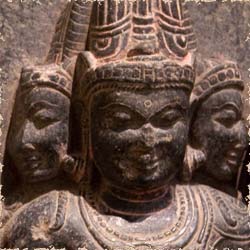
Brahma

Vishnu
Law of Three in Hinduism
Brahma, Vishnu, and Shiva
Indian scriptures personified the Law of Three as the Trimurti: Brahma, Vishnu, and Shiva. Their intervention ensured the cosmos was kept in perpetual renewal. The health of the cosmos depended on an equilibrium between good and evil. As long as this equilibrium was kept, its existence was guaranteed. At times, however, the balance was disturbed, pushing the cosmos to the verge of peril. In these dangerous instances, Vishnu, as sustainer God, was responsible for restoring order. He did so by incarnating into an earthly form that suited the occasion.
Stories of demon-kings gaining disproportionate strength and upsetting the cosmic balance — along with Vishnu’s Avatars cunningly neutralizing them — inspired the greatest Hindu epics. The details of each myth varied but the underlying principle remained the same: the cosmos was upheld by the proper combination of three forces: good, evil, and equilibrium; or active, passive, and neutralizing. The ancient Hindu cosmologists had observed and coined the Law of Three.
[GURDJIEFF] Every independent cosmic unit, great or small, must consist of all three sacred ‘substance-forces’ of the [Law of Three]… and must constantly maintain them in a corresponding and balanced state. And if for some reason or other an excess of the vibrations of one of these three sacred forces enters into any presence, [it results in] the total destruction of its ordinary existence.iii

Brahma

Vishnu
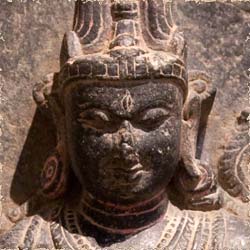
Shiva

Shiva



Law of Three in Judaism
In contrast with Hindu polytheism, the Hebrew Bible emphasized the existence of a single god. Nevertheless, in any given instance in the Bible, this single god invariably played the role of creator, sustainer, or destroyer. God created the world in the beginning of the Book of Genesis, sustained his people in the story of Exodus, and destroyed his creation in the Biblical flood. In accord with the Hindu worldview, the Biblical world also had to cycle through these three phases endlessly, each inspiring the stories that populate the entire Bible. The Hebrew philosophers observed and coined the Law of Three.
Hospitality of Abraham
One particular story from the Book of Genesis features this threefold nature straightforwardly. God visits his servant Abraham. Throughout the visit, God vacillates between a single and threefold visitor.
The Bible prefaces this story by saying, “And the Lord appeared unto [Abraham] in the plains of Mamre: and he sat in the tent door in the heat of the day…” But when Abraham gazes up to see his visitor, he witnesses three men. He runs to meet them, and yet addresses them in signal person: “And when [Abraham] saw them, he ran to meet them from the tent door, and bowed himself toward the ground, And said, My Lord, if now I have found favor in thy sight, pass not away, I pray thee, from thy servant.”
As the story unfolds, we learn that Abraham’s mysterious visitor(s) plays a threefold role. In accepting Abraham’s hospitality, and in sitting at his table to eat, we witness the principle of sustainer. In in quiring about Abraham’s wife, and announcing she will soon bear a son, we witness the principle of creator. And finally, in leaving Abraham’s table to destroy Sodom and Gomorrah, we witness the principle of destroyer.



Law of Three in Christianity
As the trunk and governor of the universe, the creator enjoys complete freedom. The immediate branches diverging from him, however, come under a few laws to maintain his intention and will. The next divergence comes under more, and so on, until we reach the extremes of the ray of creation, under the most number of laws.
If a force from a higher level seeks to intervene in a lower world, it must regard its laws. Otherwise, its intervention will destroy the cosmic order. The earth is positioned on a relatively low level on the ray of creation, under many more laws than the worlds above it. One of these is the law of physicality. Therefore, to intervene in the affairs of earth, a higher force must assume a physical body; it must incarnate. Hinduism implied this by having Vishnu incarnate to periodically restore the balance between good and evil. Christianity implied it by portraying its founding figure, Jesus of Nazareth, as an incarnation of God.
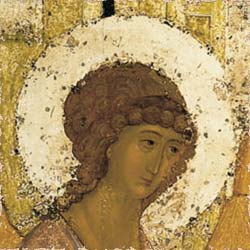
God the Father

The early Church Fathers saw in the story of Abraham’s Hospitality a prefiguration of the Holy Trinity. Artists drew inspiration from the scene of God visiting Abraham to portray the Father, Son, and Holy Ghost. At first, they depicted the three visitors as angels seated at a table hosted by Abraham and Sarah. With time, however, the hosts assumed a secondary position to their angelic visitors. By the time Andrei Rublev painted his version of the Trinity — a masterpiece of Russian icon painting that would become the standard for this subject — Abraham and Sarah vanished altogether. Only Father, Son, and Holy Ghost remained. The One that became Three in order to redeem mankind; the Christian version of the Law of Three.
By portraying the three angels as identical, Rublev replicates the Genesis enigma: is God one or three? Moreover, now that Abraham and Sarah are absent, the angels might be seated anywhere. The middle angel reaches out to a cup on the table. This has been understood to convey the willingness of God the Son to make the sacrifice of incarnating and redeeming mankind. By this interpretation, the scene to follow should be the Annunciation, in which Mary conceives by the Holy Ghost and God assumes physical form.
[OUSPENSKY] The Law of Three explains many things that cannot be explained in the ordinary way, because we usually think about only one force. Very seldom do we take the second force, resistance, into consideration, and never the third force. Yet, in any calculation of actions it is necessary to take three forces into account.iv

God the Father
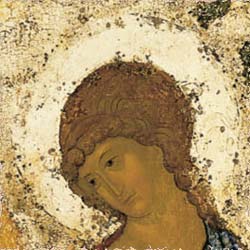
God the Son
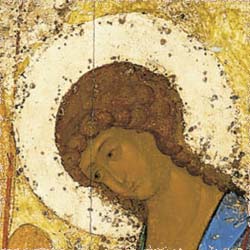
God the Holy Ghost

God the Son

God the Holy Ghost


Sources
- In Search of the Miraculous by Peter Deminaovich Ouspensky
- Views from the Real World by George Ivanovich Gurdjieff
- Beelzebub’s Tales to His Grandson by George Ivanovich Gurdjieff
- The Fourth Way by Peter Ouspensky

In 2022/3, BePeriod will be creating a full-length documentary on George Gurdjieff
Subscribe to our mailing list
Subscribe to our mailing list
Continue Reading:
© BePeriod
